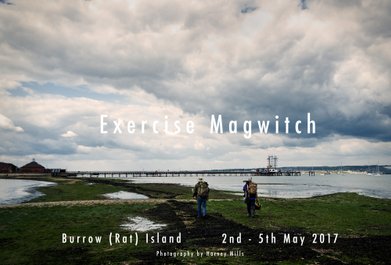Ex Magwitch 'aka'
Rat Island
During the winter storms of early 2014, sand on the beach and forshore of Burrow Island was washed away in the severe winter weather conditions and spring tides, exposing the remains of several individuals. Operation Nightingale carried out emergency recovery work at the site after a member of the public alerted the police to the remains.
In order to further understand the origins of the remains and the historical context of the burial site, a more comprehensive excavation was planned, and with the assistance of Cranfield Forensic Institute, we set off once again to recover any remains that might have been left from the rescue operation in 2014 and to further assess the formation of the Island.
We have been going back to 'Rat Island' for several years, usually in the spring to assess what damage costal errosion is doing to this man made island. Each season we are faced with more burials that are at risk of becoming lost to the sea and each season we are challenged to come up with ever more ingenious ideas to record and recover the remains safely from the cliff face.
Historical Setting
Burrow Island it seems, was the final resting place for some of the convicts that had been convicted of crimes and ordered to serve out their time on the Prison Hulks. Prison Hulks were floating, decomissioned ships that were used around the turn of the 19th Century (1800's), to hold convicted prisoners or french prisoners of war in Portsmouth Harbour. Nearly two dozen prison hulks were moored from the period 1796 to 1814, housing well over 7,000 men at any one time.
For nearly two centuries there has been an urban myth surrounding Burrow Island. Hoards of rats feasting on the bones of prisoners was a story that was told to me in 2012 by the local boat tour from the Historic Dockyard.
Charles Dickens immortalised the Prison Hulks in 'Great Expectations' with the introduction of Abel Magwitch, who was an escaped convict. Dickens being born and bred in Portsmouth, would have been well aware of the hulks and their reputation.
Returning an Identity
We have yet to recover any personal artefacts that might enable us to identify one of these individulas recovered at Rat Island. However, modern technological advances have enabled us to recreate the face of one skeleton. Liverpool John More University's Facelab, were able to scan the skull of one of the deceased and recreate what he would have looked like when he was alive. The only artistic lisence has been in the application of facial hair, hair style/colour and clothing. These details were taken from historical references, such as how often prisoners were expected to shave and what type of dress would have been worn by convicts in these circumstances.
We will probably never know the name of this individual, but, what we have done is given him back some identity, even if it is only his face.



